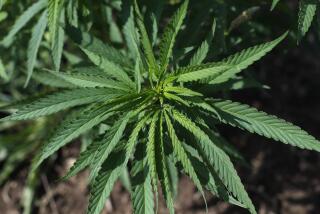Feds’ Needless Pot War
- Share via
A confrontation has been escalating between the state of California and the federal government since the state legalized medicinal marijuana in 1996. The big artillery came into play Tuesday as the U.S. Supreme Court issued a temporary injunction barring distribution of marijuana in the state for any use, even for terminal cancer patients. It is an impasse that could have been predicted. It could also have been prevented if the Clinton administration had shown responsible leadership on the issue.
Medical experts have long recommended that the government move marijuana from its current, illogical status as a Schedule 1 drug--with substances like heroin, deemed to have no possible medicinal value--over to Schedule 2, the category for potentially addictive drugs like morphine and cocaine that nevertheless have some accepted medical use. In 1988, after the federal Drug Enforcement Administration held hearings in response to a petition asking that marijuana be transferred to Schedule 2, the DEA’s own administrative law judge recommended such a transfer. But top DEA officials declined to do so. More recently, a report by the federal Institute of Medicine last year concluded that marijuana is valuable for many patients for whom other medications do not work.
The Clinton administration is obviously reluctant to be seen as sanctioning a drug that many Americans associate with the drug-abusing excesses of the 1960s, including those of the president who “never inhaled.” In fact, moving marijuana to Schedule 2 would help rein in potential abuses by the ad hoc cannabis buyers’ clubs that have formed in California and the states that joined in passing laws to sanction medical marijuana--Alaska, Arizona, Hawaii, Maine, Oregon and Washington.
There is little evidence that the clubs are distributing marijuana to those without legitimate medical needs, but there is little oversight now to prevent them from doing so. This laxity was a big factor in The Times’ opposition to the 1996 legalization measure, Proposition 215. The measure also permits physicians to prescribe marijuana not just for serious conditions like cancer and AIDS, but for “any . . . illness for which marijuana provides relief.”
Short of moving marijuana off of Schedule 1, the Clinton administration could at least try toning down needlessly confrontational rhetoric of the sort seen in the courtroom of U.S. District Judge William Alsup earlier this month, when Justice Department lawyers argued that physicians who recommend marijuana as a medical treatment should be stripped of their licenses to prescribe drugs. California officials are doing the best they can to responsibly implement Proposition 215. On Tuesday, the University of California announced that it will open a new cannabis study center at UC San Diego to develop scientific data to help counties craft guidelines for the medical use of marijuana.
Now it’s Washington’s turn. The administration should relax federal laws to allow physicians to administer marijuana under controlled circumstances. The alternative, as Proposition 215 showed, is to watch voters at the state level throw off almost all controls.
More to Read
Sign up for Essential California
The most important California stories and recommendations in your inbox every morning.
You may occasionally receive promotional content from the Los Angeles Times.










